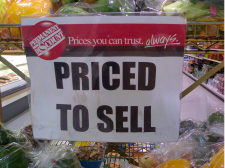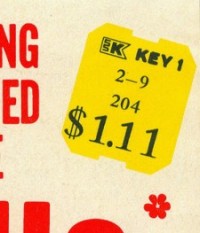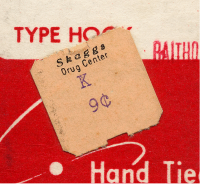TW Column by David Biddle
Don’t Treat Your Work Like Canned Tomatoes
At the beginning of December, I reduced the online price of my novel and a story collection. I wanted my books to be part of the holiday sales craze, so I took the e-book versions from $4.99 to 99¢. My royalties at those prices? About 30¢ a sale.
I smiled when I told my wife that I’d done this—a crooked, sad, maniacal smile. She gave me her best “WTF!” expression. And as it’s turned out, I should have paid attention.
 It’s way too easy for us indie authors to devalue what we’re selling. Way too easy. If we don’t rack up downloads right away, we go into pricechopper mode, as if our work is the equivalent of a can of stewed tomatoes that hasn’t moved.
It’s way too easy for us indie authors to devalue what we’re selling. Way too easy. If we don’t rack up downloads right away, we go into pricechopper mode, as if our work is the equivalent of a can of stewed tomatoes that hasn’t moved.
What’s the best price for an indie e-book? Shoot, what’s the best price for a book in general? Publishers struggled with this issue immensely when everything was paper based. A first-run print job was a sizable risk, even with good marketing. According to bestselling author Kathryn Rusch, who writes the blog The Business Rusch:
By the middle of the previous decade, it cost at least $250,000 to publish a mid-list novel with a nice cover and an author advance of $10,000.
But with e-books, supply is limitless. There’s no cost difference between one or a million digital downloads. The only thing any e-book author needs to worry about is demand.
That’s a big worry, though. Building demand for a book is hard as hell for individual authors. You have to account both for what customers expect and what they value. The latter often comes down to subjectively defined qualities like skilled editing, effective plotting, character development, and use of language.
In the early days of e-book distribution, it was all about attracting readers. The best price back in 2009, when the Kindle was introduced? Free.
Many of the initial successful indies—like romance novelist Judy Powell and humorist/blogger Rachel Thompson—built big audiences by using what was then an open-ended system at Amazon that allowed them to offer at least some of their work for nothing.
In an interview with Forbes last fall, Mark Coker, founder of Smashwords, says of a company study about e-book price points:
At the Apple iBook store, free books are downloaded about 100 times more than paid books. The lesson for authors who want to rapidly build their platform is that free books are a very powerful tool.
Yet, even if you opt for this tried-and-true route, there’s really no more “free” on Amazon—or Barnes and Noble, for that matter.
Last year, Amazon introduced its Kindle Direct Publishing (KDP) system, which has many fabulous features. As one example, in an industry notorious for inaccurate and incomplete reporting to authors and agents, its real-time online reporting system is a big fat raspberry at traditional publishers.
 But the most prominent feature of KDP is a pricing system that allows the author to set his or her book between $2.99 and $9.99 in exchange for getting 70 percent of the take. KDP also allows authors a more flexible price range of 99¢ to $200 if they’re willing to accept royalties of 35 percent.
But the most prominent feature of KDP is a pricing system that allows the author to set his or her book between $2.99 and $9.99 in exchange for getting 70 percent of the take. KDP also allows authors a more flexible price range of 99¢ to $200 if they’re willing to accept royalties of 35 percent.
At Amazon, the lowest you can go with price is a penny off the dollar —with one exception. KDP members are allowed five “free days” in each 90-day period if they’re willing to sign a deal where they sell their digital title only through Amazon’s Kindle Store.
In 2012, many indie writers gave the “free day” concept a shot (or two or three). I did a three-day August run that resulted in 10,100 downloads of my novel. Some other indies have reported getting as many as 50,000 downloads when their books were free.
If you’re an unknown author, that’s absolutely amazing. It matches Coker’s findings in the Smashwords study.
But you burn through those days quickly, get drunk on the idea that so many people have your book, and then must reenter the real world of charging for your writing. In my case, after my free days, I priced my book at $2.99. I got two downloads the day after and then nothing for several weeks, no matter what marketing I did. By the end of September, I’d had enough. I’d written a great story that was professionally edited and formatted. If it could sit at $2.99 with no purchases, why not have at least a little pride and make it $4.99.
In fact, while Coker points out that, logically, 99¢ books sell better than $1.99 books and $1.99 books sell better than those priced at $2.99, here’s his key observation:
As price increased there were fewer sales. But what price yields the greatest income? And that was really interesting: We found that the $2.99 to $5.99 price band appears to be the sweet spot for indie authors, those prices over-performed the average in terms of income for the author. But 99¢ and $1.99 under-performed.
That’s because books aren’t commodities. They aren’t even really consumer items in the conventional sense. Each book is a unique world that readers step into and keep safe on a shelf or in their Kindles when they’re done.
Customers may love discounts on bestsellers, but they don’t buy any old book just because it’s cheap. Try imagining the equivalent of a supermarket sale sign, and you’ll see the problem:
While Supplies Last!
Prices Slashed on Sexy Literary Thriller!
Less Than a Can of Tomatoes!
You can’t replace one book with another. For instance, I just bought the paperback version of Haruki Murakami’s mammoth 2011 novel 1Q84 for about $20. It’s fabulous. I also have roughly 20 books that I’ve downloaded for free this year from indie authors I know and another 50-plus that I’ve purchased for anywhere from $1 to $3.
But I’ve read very few of those downloaded e-books. I regularly attempt to, but things keep getting in the way—yet I am reading Murakami, an established literary author, in paper.
 So: Are we trying to sell books? Or to get people to read them—to enter the worlds we’ve created?
So: Are we trying to sell books? Or to get people to read them—to enter the worlds we’ve created?
That’s not a rhetorical question.
Experienced authors like thriller writer Wesley Dean Smith regularly offer suggestions to indies about pricing. Here are his latest recommendations for 2013:
-
Novels: $6.99 – $7.99
-
Short Books: $3.99
-
Short Stories: $2.99
-
Short Story Collections: $4.99 – $7.99 (depending on the number of stories)
For Smith, indies are competing with traditionally published books. He also astutely points not only to the digital/paper divide but also to the psychology of buying books in either form. “If you have a $16.99 trade paper and a $7.99 electronic novel, it looks right to buyers,” he says.
The thing is, most indie authors don’t pay attention to this advice. The majority of indie e-books are priced from 99¢ to $2.99. That’s a lot of “WTF!” spousal faces.
But if Kindle and iPad owners liked an author’s 99¢ mystery or romance novel last year, maybe they’ll be willing to pay $4.99 or $5.99 for another book by the same author this year. Maybe they’ll pay $6.99 and $7.99 for other titles the following year.
Which brings me back to that beautiful face my wife made in December. She was right—and I’m paying attention.
In early January, I raised my prices to be more in line with what Dean Wesley Smith advises. As I move forward, I’m hoping that my potential readers will see value when they look at the price tag—rather than a deal.
I have a new novel coming out this spring. I assure you, it will not be sitting on the floor somewhere with a 99¢ sticker on it. But even at $6.99, it will be less than any traditionally published novel out there.
Publishing Information
- “The Business Rusch: Scarcity and Abundance” by Kristine Kathryn Rusch, The Business Rusch, March 14, 2012.
- “How to Be a Best Seller on Amazon: An Interview with Multi-Category Best Selling Author Judy Powell” by Vikram Narayan, BookBuzzr, May 4, 2012.
- RachelintheOC: Rachel Thompson’s blog.
- “Mark Coker: Indie Authors Are Underpricing Their Books” by Suw Charman-Anderson, Forbes, August 3, 2012.
- “The New World of Publishing: Pricing 2013” by Dean Wesley Smith, The Writings and Opinions of Dean Wesley Smith, September 14, 2012.
- “Self-Publishers Aren’t Killing The Industry, They’re Saving It” by David Gaughran, Let’s Get Digital, November 5, 2012.
Art Information
- "Priced to Sell?" © Antony Pranata; Creative Commons license
- "Kmart Faux Sticker Key 1" © Ganas Gan; Creative Commons license
- "Skaggs Drug Center, 1960's" © Roadsidepictures; Creative Commons license
 David Biddle is a contributing writer at TW. His Talking Indie column recounts the ups and downs of being an independent publisher.
David Biddle is a contributing writer at TW. His Talking Indie column recounts the ups and downs of being an independent publisher.
You’ll find information about his novel Beyond the Will of God and other digital fiction on davidbiddle.net.
“I felt sleazy and pathetic. I’d been reduced to begging my family and friends to buy my book.” — “Sorry, Your Buddies Won’t Buy Your Book”
